Last week, comedian and actor Vir Das tweeted about how a trusted companion on his trips around the world is his steel plate, which he can’t eat without. He noted that the thali fits nicely during check in, is easy to wash, and is versatile enough to accommodate for different cuisines, including japanese and italian.
The steel plate is also comfortable to hold in a party where guests usually find it difficult to balance bowls in a fancy plate, he noted.
OCD confession. I can’t eat without this thaali. Travels the world with me. Fits nicely in check in, easy wash instead of multiple dishes, works for desi food/sushi/Italian all cuisines, and great for standing at a party where people can’t balance bowls in fancy ass plates. pic.twitter.com/tq7d35VZ66
— Vir Das (@thevirdas) December 16, 2021
As soon as the post went online, several people chimed in to talk about how they resonated with the tweet, and of their emotional attachment with thalis. This might be a far-fetched or exaggerated emotion for those outside India, but for those of us within, the plate has been an integral part of desi households for centuries now.
Bronze, stainless steel, brass, clay and even gold thalis are used for all three meals, and the material usually depends on family tradition.
For instance, my family has been eating on brass plates for several generations. I have become so used to the golden-coloured plate that I know exactly where different food items like pickle, papad, dahi, roti and sabzi will be placed. Even a tiny displacement makes me restless.
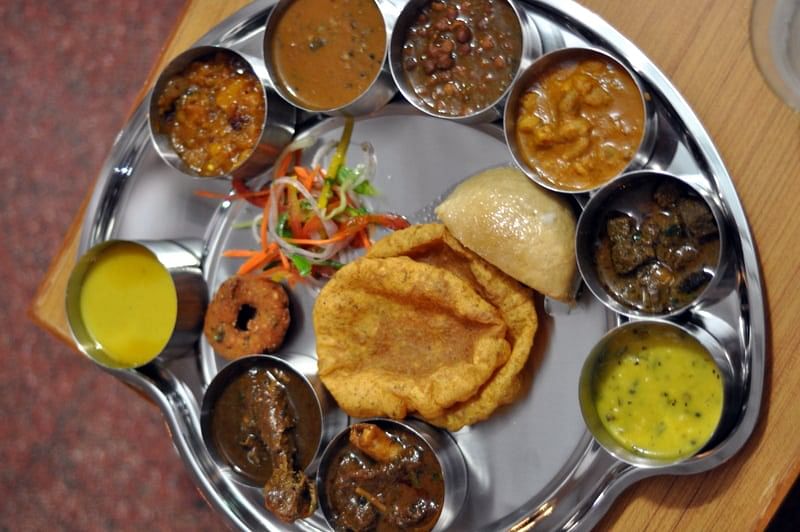
Thalis made of stainless steel, complete with compartments for dal, rice and sabzi, are another widely used variety in the country. The compartment eliminates the need to take other utensils for liquid-based gravy. The segregation is also a great way to ensure all nutrients from carbohydrates (roti), proteins (subzi) to calcium and iron (rice).
Eating from a stainless steel plate is also sustainable when compared to plastic or paper alternatives. It can be repurposed innumerable times – every time it’s washed, it’s as new as ever. Besides, the plate is rust proof, durable, and a great conductor of heat, which means that it keeps your food hot for a long time. Compared to its brass and copper counterparts, it is lightweight and easy to carry.
Steel plates mainly consist of iron, chromium and nickel, which are considered healthy minerals. The benefits of steel plates are known globally. In May this year, actor Mayim Bialik, aka Amy from ‘The Big Bang Theory’ announced that she was switching to steel utensils, including the ‘thali’, for eco-conscious reasons.
But besides convenience and nostalgia, there are other reasons why the thali has remained such a vital aspect of our culinary evolution.
Have you ever wondered about the placement of sweets, pickles, salads or rice in a thali? Or why each thali, irrespective of the geographic region and community, comprises so many dishes?
“A multi-course meal that starts with the first sip of water proffered to an arriving guest, thali can continue into as lavish a spread of food as the host can afford, wind up with delectable desserts and conclude with a selection of mukhwas and paan, mouth fresheners and digestives eaten at the end of a meal,” Rushina Munshaw Ghildiyal, culinary chronicler and curator of food experiences, told Times of India.
What makes thali a wholesome meal?
India offers numerous thalis such as Gujarati, Punjabi, Konkani, Goan, Rajasthani, Andhra, Kashmiri and more. But unites these, however, is the perfect assortment of delicious indeginoues dishes on a single platter.
Every thali is exploding with different tastes like spicy, sour, sweet, salty, savoury and bitter. This way, each part of the tongue is awakened.
A Kashmiri thali includes kebab nadir shahi (lotus stems kebabs), rajma rismise (slow cooked kidney beans), methi chaman (cottage cheese with fenugreek), Kashmiri dum aloo (potatoes in a nutty gravy), haak (green leafy vegetables), khatte baingan (spicy and sour brinjal), mutton rogan josh (signature Kashmiri lamb curry), Kashmiri pulao (spicy rice with nuts), al raita (bottle gourd in yoghurt) and doon chetin (apple chutney). The feast ends on a sweet note with phirni, a rose and saffron flavoured rice custard.
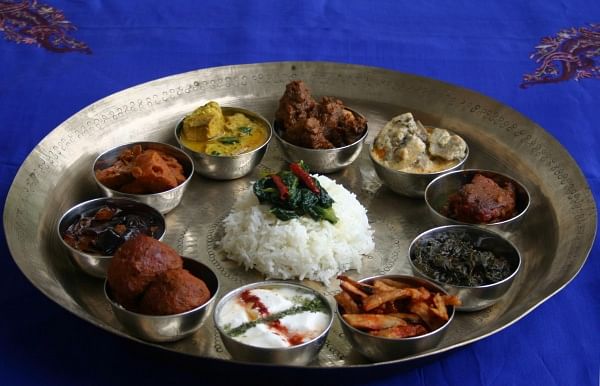
The different ingredients that are added to achieve a perfect combination of six tastes, or Shad Rasa, an ayurvedic concept, is also significant from a nutritional point of view.
If grains and lentils are a powerhouse of proteins, raita or pickle is good for digestion, and tempering (or tadka) provides essential vitamins of spices like curry leaves, mustard seeds and cumin seeds. Curry leaves are beneficial for fighting infections.
Meanwhile pulses such as rajma-chawal or bisibelle bhat ensure essential amino acids that build antibodies. Raw vegetables in the form of salad provide vitamins, minerals and antioxidants.
Finally, fermented foods like dosa, idli, and khaman are good sources of probiotics and vitamin K2. Don’t forget to squeeze that half served lemon for vitamin C and absorption of iron from food dishes.
To ensure that a person enjoys every dish without different tastes overpowering one another, most thalis have palate cleansers. These items help remove food residue so that one savors a drink and dish.
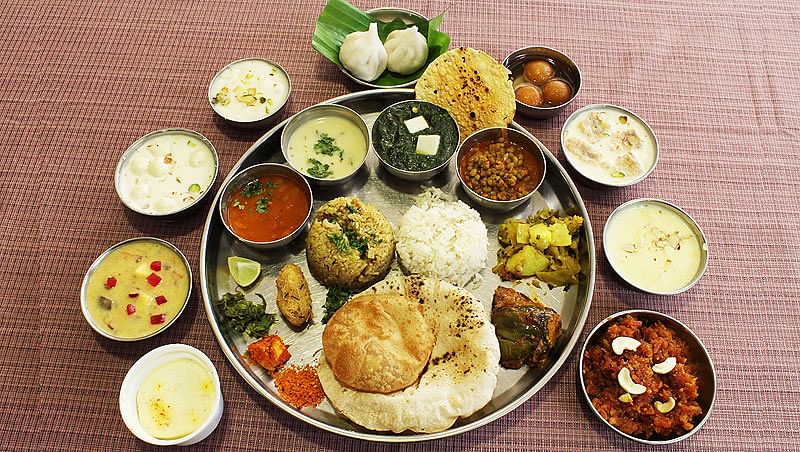
For example, in a Manipuri thali, cabbage salad does the work and in Uttar Pradesh, it is the kachumber. In Maharashtrian thali, the aam panna is used. In Oriya thali, ripened papaya or coconut meat helps. These cleansers also help in eliminating the need to drink water after every dish.
Besides the ingredients, a thali also displays the different styles of cooking in India such as frying, boiling, grilling, fermenting, bhuno, dhuunaar (smoking), poaching, etc. For instance, in a Gujarati thali, dhokla is fermented, rice is boiled and pooris are deep fried.
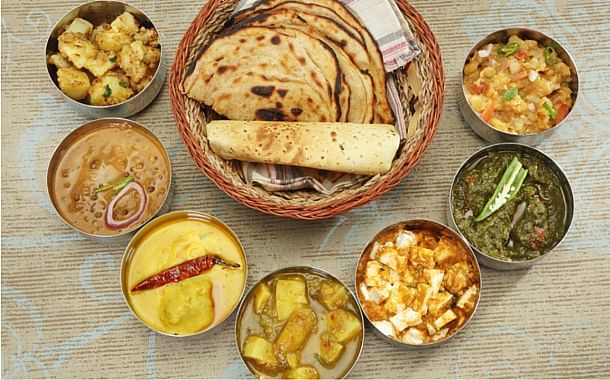
Additionally, the thali offers an array of texture and colours too such as grainy, coarse, granular, smooth, dry and wet dishes. The yellow of the khaman dhokla, white of the buttermilk, green leafy vegetables, brown pulses and the redness of tomatoes – every thali is an explosion of colour.
As for the placing of food dishes, the focus is on the first and last dish, said Chef Milan Gupta. “A lot of emphasis was laid on plating to make sure the first and last dish created the desired impact in terms of taste and digestion process. For example, dahi must be eaten in the end, as it supports digestion by introducing probiotics.”
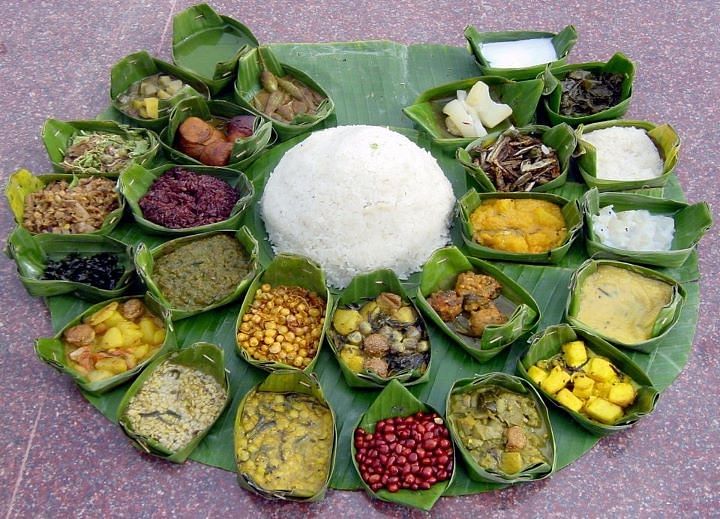
Another important reason why there are so many dishes in a thali could be the importance given to sitting cross legged or on the dining table. In royalty, the norm is to not get up while having a meal and wait till everyone finishes their food.
Now that you have a better idea of what an Indian thali entails and the significance behind each aspect, share it with the foodies out there.
Click here to read about 20 ultimate thalis that will take you straight to the food heaven.
Edited by Divya Sethu
No comments:
Post a Comment